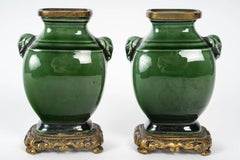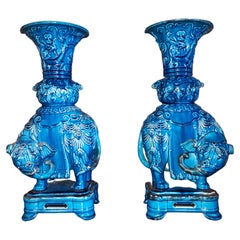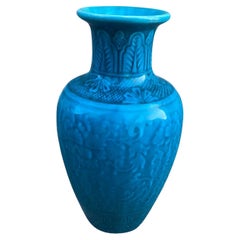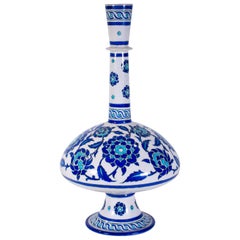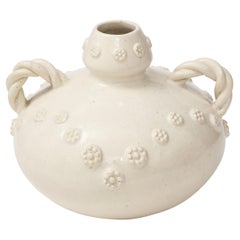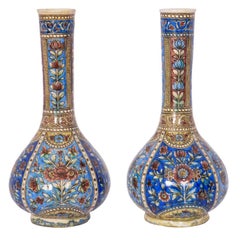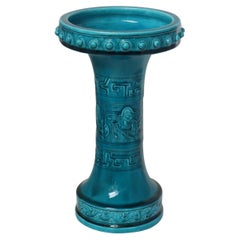Theodore Deck Decorative Objects
9
to
1
6
3
9
9
9
1
9
Height
to
Width
to
9
5
5
3
2
9
9
8
1,318
740
493
451
Creator: Theodore Deck
Théodore Deck (1823-1891), Miniature Pair of Faience Vases circa 1870
By Theodore Deck
Located in Saint-Ouen, FR
Theodore Deck (1823-1891)
A deep green enameled faience miniature pair of vases molded in the Chinese Archaistic Taste.
Coves in the shape of elepha...
Category
1870s French Chinoiserie Antique Theodore Deck Decorative Objects
Materials
Faience
Pair of Theodore Deck Vases
By Theodore Deck
Located in Saverne, Grand Est
Extremely rare pair of Gu-shaped turquoise enamelled ceramic vases, carried by elephants and resting on an openwork base ending in four flared feet. Some lack of enamel otherwise ver...
Category
1880s French Japonisme Antique Theodore Deck Decorative Objects
Materials
Ceramic
Théodore Deck, Ceramic Vase, Signed, circa 1870
By Theodore Deck
Located in Saint-Ouen, FR
Théodore Deck (1823-1891), ceramic vase, signed, circa 1870.
Category
Late 19th Century French Art Nouveau Antique Theodore Deck Decorative Objects
Materials
Ceramic
A Théodore Deck (1823-1891) Enamelled Faience Soliflore Vase circa 1875
By Theodore Deck
Located in Saint-Ouen, FR
Théodore DECK (1823-1891)
A polychromatic enamelled earthenware soliflore and quadrangular shape vase with Sino-Japanese inspiration design of flowers and geometrical friezes all around.
Impressed uppercase mark "TH.DECK" under the base.
Circa 1875
Born in Guebwiller in Alsace, Théodore Deck trained as a ceramist in his home region, then in Germany. He went into partnership with his brother, Xavier Deck, to create his own factory in Paris in 1858. At the Exhibition of Industrial Arts in 1864, he presented pieces covered with transparent enamels that were not cracked, and then made his first attempts at reliefs under transparent enamels. He developed a bright turquoise color, famously renowned as "Bleu Deck". It is this nuance that we find on the salamander represented on this vase. In 1887 he published a treatise entitled "La Faïence", in which he explained some of his discoveries. That same year, he became director of the Manufacture de Sèvres.
Theodore Deck (1823-1891) is a French ceramist born in Guebwiller in Alsace. He is passionate about chemistry and the physical sciences. In 1841, he joined the master stove maker Hügelin father as an apprentice in Strasbourg. In two years, he learned of the methods inherited from the 16th century, such as the encrustation of colored pastes in the style of Saint-Porchaire. This apprenticeship did not prevent him from spending his free time draw-ing or modeling clay in the studio of sculptor André Friederich. Escaping military service, he made a tour of Germany as is the tradition with fellow Alsatian stove-makers. The quality of his work allows him to obtain important orders in Austria for the castles of the provinces and the imperial palaces, in particular for the palace of Schönbrunn. He continues his journey in Hungary to Pest, to Prague, then, going north through Dresden, Leipzig, Berlin and Hamburg. On the strength of his apprenticeship, he arrived in Paris in 1847. Recommended by Hügelin, he went to the stove factory of the Bavarian potter Vogt, located rue de la Roquette. The Revolution of 1848 interrupts production and Deck decides to return to his hometown. His family then advised him to set up a small terracotta workshop: he made a few busts, statuettes, vases, lamps and copies of famous antiques there. Aware that this situation would not allow him to provide for himself properly, he returned to Paris in 1851 where he was employed by the widow Dumas, daughter of the earthenware maker Vogt for whom he had worked. Hired as a foreman, he supplied the drawings and models to the workers, while working the land himself.
The following year, he made the decision to settle not far from his former employer at 20, rue de la Fontaine-au-Roi, probably using his ovens. His brother, Xavier Deck, joins him. It was officially in 1858 that the Deck brothers created their business and settled in Paris at 46, boulevard Saint-Jacques. Initially, the brothers only carry out coatings for stoves. But the business is going so well that barely a year after their installation, they want to diversify their production and engage in ceramics for the cladding of buildings as well as in shaped parts. Deck is interested in politics. In 1870, he opted for French nationality and was elect-ed deputy mayor in the 15th arrondissement of Paris.
In 1861, at the Salon des arts et industries de Paris, which was held on the Champs-Élysées, Théodore Deck exhibited his works for the first time: these were pieces with an inlay decoration called “Henri II” and others. pieces covered with turquoise blue enamel or decoration in the style of Iznik ceramics.If he wins a silver medal, reviews are mixed, however. The following year, on the occasion of the Universal Exhibition of 1862 in London, he won over English customers. He surprised by presenting, like the previous year, his Alhambra Vase...
Category
1870s French Japonisme Antique Theodore Deck Decorative Objects
Materials
Faience
Large Theodore Deck Earthenware Bottle Form Vase in the Islamic/Iznik Taste
By Theodore Deck
Located in New York, NY
A large and impressive Theodore Deck Earthenware bottle form vase in the Islamic/Iznik Taste, Impressed "TD" 1870 on the bottom. The narrow circular neck is decorated with dark blue,...
Category
1870s French Islamic Antique Theodore Deck Decorative Objects
Materials
Porcelain
Theodore Deck '1823-1891', a Japonisme Polychromed Faience Quadrangular Vase
By Theodore Deck
Located in Saint-Ouen, FR
Theodore Deck (1823-1891)
A Polychromed Faience quadrangular vase, decorated in a cartouche with butterfly and birds on branches of prunus and peonies in the Japanese Taste on a pu...
Category
Late 19th Century French Japonisme Antique Theodore Deck Decorative Objects
Materials
Faience
Pair of Gilt Bronze Mounted Faience Lamps by Deck
By Theodore Deck, Gagneau Frères
Located in London, GB
These beautiful table lamps are by Théodore deck, one of the most important ceramicists of the 19th Century, and Gagneau Frères, a leading bronzier. Deck was the director of a presti...
Category
Late 19th Century French Antique Theodore Deck Decorative Objects
Materials
Ormolu, Bronze
French Chinoiserie Style Earthenware Turquoise Blue Ground Planter or Jardinière
By Theodore Deck
Located in New York, NY
A marvelous French chinoiserie style earthenware dore bronze mounted turquoise blue ground planter or jardinière, attributed to Théodore Deck. The ceramic bowl is beautifully decorat...
Category
1880s French Chinoiserie Antique Theodore Deck Decorative Objects
Materials
Bronze
Pair of Ormolu-Mounted Theodore Deck Faience Persian-Blue Vases with Lampshades
By Theodore Deck
Located in Palm Desert, CA
A pair of late 19th century ormolu-mounted faience Persian-blue vases by Theodore Deck, mounted as oil lamps. As in traditional Persian design, the lamps are bottle-shaped, with a wi...
Category
19th Century French Antique Theodore Deck Decorative Objects
Materials
Ormolu
Related Items
A French Faience Vase
Located in New York, NY
A unique and beautiful faience jug attributed to French ceramicist Emile Tessier. One of a series in our inventory, this vase not only has a beautiful form, but it features hand-scu...
Category
Mid-20th Century French Theodore Deck Decorative Objects
Materials
Ceramic
Pair 19th Century Antique Islamic Ottoman Iznik Kutahya Bottle Vases Turkey 1820
Located in Portland, OR
A good pair of antique early 19th century Ottoman Islamic Iznik/Kutahya pottery bottle vases, Turkey, circa 1820.
The vases of bottle form with a flare...
Category
Early 19th Century Turkish Islamic Antique Theodore Deck Decorative Objects
Materials
Pottery
Pair of Large Stunning Burmantofts Faience Floral Vases
By Burmantofts Pottery
Located in Bishop's Stortford, Hertfordshire
A stunning pair of Burmantofts Faience vases of slender baluster form, cast in low relief with flowers and foliage, in shades of blue, turquoise, green, yellow and red on a cream gro...
Category
1880s English Antique Theodore Deck Decorative Objects
Materials
Pottery
Petite French Faience Vase Desvres, circa 1900
By Desvres
Located in Austin, TX
Small French faience jardinière with floral pattern Desvres, circa 1900.
Category
Early 1900s French French Provincial Antique Theodore Deck Decorative Objects
Materials
Ceramic, Faience
Ceramic Vase with White Glaze Decoration, Signed Lion, circa 1920-1930
By Eugène Lion
Located in Saint-Ouen, FR
A ceramic vase with white glaze decoration.
Perfect original conditions.
Signed "Lion" under the base,
circa 1920-1930.
Category
20th Century French Art Deco Theodore Deck Decorative Objects
Materials
Ceramic
Pair of French Faience Vases by Jules Vieillard
Located in Winter Park, FL
Pair of 19th century French faience vases by Jules Vieillard of Bordeaux. Italian Renaissance style decoration depicting Venus. Mint condition. Mark to underside: JVB. Please refer t...
Category
19th Century French Renaissance Antique Theodore Deck Decorative Objects
Materials
Faience
Eugene Deutch Signed Mid-Century Modern Studio Pottery Ceramic Vase, 1950
By Eugene Deutch
Located in Studio City, CA
Wonderful work my well-known Hungarian-born, Midwest potter Eugene Deutch.
This magnificently glazed vase/ vessel features a dark, rich glaze that drips freely down the inside of the work.
Signed and dated (1950) on the underside.
Would make for a great addition to any midcentury pottery collection or eye-catching Stand-alone work in about any setting.
Deutch's work is held in many private collections and museums and he was exhibited in solo shows at the Dallas Museum of Art...
Category
1950s North American Mid-Century Modern Vintage Theodore Deck Decorative Objects
Materials
Ceramic
Ceramic Vase, Italy, circa 1950s
By Giovanni de Simone
Located in San Diego, CA
Beautiful midcentury hand painted ceramic vase.
Italy, circa 1950s.
Category
1950s Italian Mid-Century Modern Vintage Theodore Deck Decorative Objects
Materials
Ceramic
French Faience Vase HB Quimper, Circa 1920
By Quimper Faience Pottery
Located in Austin, TX
French Faience vase signed HB Quimper Circa 1920.
Category
1920s French Rustic Vintage Theodore Deck Decorative Objects
Materials
Faience
Postmodern Brown Enameled Earthenware Vase by Bitossi
By Bitossi
Located in Bresso, Lombardy
Made in Italy, 1970s.
This is a brown enameled earthenware vase with a linear pattern of different colors.
It is a vintage item, therefore it might show slight traces of use, but it...
Category
1970s Italian Post-Modern Vintage Theodore Deck Decorative Objects
Materials
Earthenware
Amazing Ceramic Vase by Accolay, circa 1960-1970
By Accolay Pottery
Located in Neuilly-en- sancerre, FR
An amazing ceramic vase by Accolay with abstract decoration.
Perfect original conditions.
Signed under the base,
circa 1960-1970.
Category
20th Century French Beaux Arts Theodore Deck Decorative Objects
Materials
Ceramic
French Faience Vase Gien Circa 1890
By Gien
Located in Austin, TX
French Faience Vase Gien Circa 1890.
Asian inspiration.
Decorated with peonies and pheasants.
Category
1890s French French Provincial Antique Theodore Deck Decorative Objects
Materials
Faience
Previously Available Items
Pair of French Theodore Deck Ormolu-Mounted Celadon Porcelain Lamps
By Theodore Deck
Located in New York, NY
A Pair of French Theodore Deck ( 1823-1891) Ormolu-Mounted Celadon Porcelain Lamps, circa 1870.
A very elegant pair of celadon green porcelain lamps in the Chinese taste, mounted ...
Category
19th Century French Antique Theodore Deck Decorative Objects
Materials
Ormolu
Theodore Deck (1823-1891) , A Chinese Archaïc Taste Blue Faience Vase circa 1875
By Theodore Deck
Located in Saint-Ouen, FR
A Theodore Deck (1823-1891) Faience Persian blue, " Bleu Deck" Diabolo shape Vase
Moulded in low relief and incised with fretwork and scrolls pattern in the Chinese Archaistic taste,
Impressed Uppercase TH.DECK mark.
circa 1875
Illustrated in "Théodore Deck ou l'éclat des émaux 1823-1891", Exhibition Catalogue held in Musée de Marseille, under # 24 page 54
Born in Guebwiller in Alsace, Théodore Deck trained as a ceramist in his home region, then in Germany. He went into partnership with his brother, Xavier Deck, to create his own factory in Paris in 1858. At the Exhibition of Industrial Arts in 1864, he presented pieces covered with transparent enamels that were not cracked, and then made his first attempts at reliefs under transparent enamels. He developed a bright turquoise color, famously renowned as "Bleu Deck". It is this nuance that we find on the salamander represented on this vase. In 1887 he published a treatise entitled "La Faïence", in which he explained some of his discoveries. That same year, he became director of the Manufacture de Sèvres.
Theodore Deck (1823-1891) is a French ceramist born in Guebwiller in Alsace. He is passionate about chemistry and the physical sciences. In 1841, he joined the master stove maker Hügelin father as an apprentice in Strasbourg. In two years, he learned of the methods inherited from the 16th century, such as the encrustation of colored pastes in the style of Saint-Porchaire. This apprenticeship did not prevent him from spending his free time draw-ing or modeling clay in the studio of sculptor André Friederich. Escaping military service, he made a tour of Germany as is the tradition with fellow Alsatian stove-makers. The quality of his work allows him to obtain important orders in Austria for the castles of the provinces and the imperial palaces, in particular for the palace of Schönbrunn. He continues his journey in Hungary to Pest, to Prague, then, going north through Dresden, Leipzig, Berlin and Hamburg. On the strength of his apprenticeship, he arrived in Paris in 1847. Recommended by Hügelin, he went to the stove factory of the Bavarian potter Vogt, located rue de la Roquette. The Revolution of 1848 interrupts production and Deck decides to return to his hometown. His family then advised him to set up a small terracotta workshop: he made a few busts, statuettes, vases, lamps and copies of famous antiques there. Aware that this situ-ation would not allow him to provide for himself properly, he returned to Paris in 1851 where he was employed by the widow Dumas, daughter of the earthenware maker Vogt for whom he had worked. Hired as a foreman, he supplied the drawings and models to the workers, while working the land himself.
The following year, he made the decision to settle not far from his former employer at 20, rue de la Fontaine-au-Roi, probably using his ovens. His brother, Xavier Deck, joins him. It was officially in 1858 that the Deck brothers created their business and settled in Paris at 46, boulevard Saint-Jacques. Initially, the brothers only carry out coatings for stoves. But the business is going so well that barely a year after their installation, they want to diversify their production and engage in ceramics for the cladding of buildings as well as in shaped parts. Deck is interested in politics. In 1870, he opted for French nationality and was elect-ed deputy mayor in the 15th arrondissement of Paris.
In 1861, at the Salon des arts et industries de Paris, which was held on the Champs-Élysées, Théodore Deck exhibited his works for the first time: these were pieces with an inlay decoration called “Henri II” and others. pieces covered with turquoise blue enamel or decoration in the style of Iznik ceramics.If he wins a silver medal, reviews are mixed, however. The following year, on the occasion of the Universal Exhibition of 1862 in London, he won over English customers. He surprised by presenting, like the previous year, his Alhambra Vase of exceptional dimensions (1.36 m in height and 2.25 m in circumference) which was purchased by the South Kensington Museum a few years later. At this same exposure, however, we notice the numerous cracks in its glaze and its poor adhesion to the dough. At the Indus-trial Arts Exhibition of 1864, Deck managed to present pieces coated with transparent, non-cracked enamels, and then made his first attempts at reliefs under transparent enamels. He developed a bright turquoise colour, which he named "Bleu Deck".
Théodore Deck explained the manufacture and qualities of these transparent enamels when he published his treatise La faïence in 1887. A year later, he made the first tests of reliefs in transparent enamels. He will never abandon this technique which will also be taken up by several large manufacturers. Inspired to pastiche by Islamic...
Category
1870s French Chinese Export Antique Theodore Deck Decorative Objects
Materials
Faience
H 10.24 in Dm 5.91 in
Theodore Deck Islamic/Alhambra Style Green-Glazed Earthenware Vase on Pedestal
By Theodore Deck
Located in New York, NY
A Monumental Exceptionally Made Islamic style green glazed earthenware three-piece vase and pedestal centerpiece. This is an extraordinary earthenwar...
Category
1890s French Islamic Antique Theodore Deck Decorative Objects
Materials
Earthenware
Théodore Deck, Ceramic Vase, Signed, circa 1870
By Theodore Deck
Located in Saint-Ouen, FR
Théodore Deck (1823-1891), ceramic vase, signed, circa 1870.
Category
Late 19th Century French Art Nouveau Antique Theodore Deck Decorative Objects
Materials
Ceramic
Théodore Deck, Tanagra, Enamelled Ceramic Sculpture, 19th Century
By Theodore Deck
Located in Beaune, FR
Polychrome enameled ceramic sculpture depicting a tanagra also called "Titeuse Dancer", resting on a rectangular base. Signature under enamel "TH.Deck". Around 1880-1890. Perfect Con...
Category
19th Century French Antique Theodore Deck Decorative Objects
Materials
Ceramic
Impressive Théodore Deck Oriental Design Enameled Faience Vase, circa 1875
By Theodore Deck
Located in Saint-Ouen, FR
Théodore Deck (1823-1891)
An Impressive baluster shape vase on a celadon background with light relief and brown decoration of scrolls, rosettes, shells and arabesques in the orienta...
Category
1870s French Archaistic Antique Theodore Deck Decorative Objects
Materials
Faience
H 22.45 in W 9.85 in D 9.85 in
Théodore Deck Faience Iznik Baluster Vase
By Theodore Deck
Located in Saint-Ouen, FR
A Théodore Deck (1823-1891) Iznik Baluster polychromed vase
Persian Islamic design
Impressed Uppercase TH.DECK Mark under the base
Dated 1870.
Category
1870s French Islamic Antique Theodore Deck Decorative Objects
Materials
Faience
Théodore Deck Faience Blue Persian Baluster Vase
By Theodore Deck
Located in Saint-Ouen, FR
A Théodore deck faience blue Persian vase
Impressed TH.DECK Mark.
Category
1870s French Japonisme Antique Theodore Deck Decorative Objects
Materials
Faience
Theodore Deck Deep Green Enamel Faience Pair of Vases
By Theodore Deck
Located in Saint-Ouen, FR
A Theodore Deck (1823-1891) deep green enamelled faience pair of vases moulded in the Chinese archaistic taste
Coves in the shape of elephant heads.
With originals Théodore deck's ...
Category
1870s French Chinoiserie Antique Theodore Deck Decorative Objects
Materials
Faience
Théodore Deck Japonisme Aesthetic Blue-Ground Faience Jardinière, circa 1880
By Theodore Deck
Located in Saint-Ouen, FR
A polychrome Theodore deck blue-ground enameled faience jardinière
of waisted flaring form, painted in the Japonisme Aesthetic with Dogrose, wisteria and other flowering branches a...
Category
1880s French Japonisme Antique Theodore Deck Decorative Objects
Materials
Bronze
Théodore Deck Blue-Persian Faience Islamic Design Jardinière 19th Century
By Theodore Deck
Located in Saint-Ouen, FR
A Rectangular Théodore Deck blue-Persian faience cachepot in the Islamic style, modelled in low relief and incised with interlacing and rosette pattern.
With original zinc planter r...
Category
Late 19th Century French Islamic Antique Theodore Deck Decorative Objects
Materials
Faience
H 5.52 in W 16.54 in D 8.67 in
Theodore Deck, Japonisme Polychromed Faience Baluster Vase
By Theodore Deck
Located in Saint-Ouen, FR
A Theodore Deck (1823-1891) polychromed Faience Baluster vase, the body richly decorated with vegetation’s, birds, butterflies and stork in the Japanese Taste in Cloisonné Imitation
...
Category
Late 19th Century French Japonisme Antique Theodore Deck Decorative Objects
Materials
Faience
Theodore Deck decorative objects for sale on 1stDibs.
Theodore Deck decorative objects are available for sale on 1stDibs. These distinctive items are frequently made of ceramic and are designed with extraordinary care. There are many options to choose from in our collection of Theodore Deck decorative objects, although blue editions of this piece are particularly popular. Many of the original decorative objects by Theodore Deck were created in the Art Nouveau style in france during the 19th century. If you’re looking for additional options, many customers also consider decorative objects by L'Escalier de Cristal, and Charles Masse. Prices for Theodore Deck decorative objects can differ depending upon size, time period and other attributes — on 1stDibs, these items begin at $2,461 and can go as high as $82,324, while a piece like these, on average, fetch $15,090.
